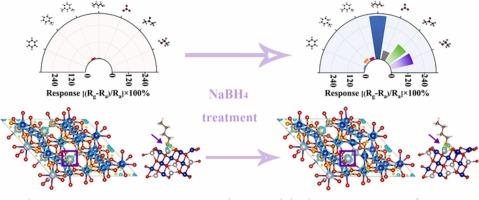Regulating microscopic surfaces and structures to boost n-butanol sensing performances in NiCo2O4/NiO composites
IF 8
1区 化学
Q1 CHEMISTRY, ANALYTICAL
引用次数: 0
Abstract
Transforming gas sensing materials from having no performance to presenting high sensing selectivity is full of challenges. For this purpose, water bath assisted sodium borohydride (NaBH4) treatment is developed and is employed to boost gas sensing dynamics of spinel structure NiCo2O4 microspheres. The n-butanol recognition, gas adsorption and carrier transport in the sensing process are tremendously optimized by etching crystal surfaces, breaking metal oxygen bonds, increasing surface area, enhancing oxygen vacancies and dislocation density, reducing crystallite size as well as forming NiCo2O4/NiO heterojunction. The NiCo2O4 microspheres treated by 0.5 M NaBH4 solution (NCO-0.5) present apparent n-butanol gas response and sensing selectivity compared to the untreated NiCo2O4 microspheres without sensing performance. The density functional theory (DFT) calculation based on adsorption energy and charge density difference further validates the evident adsorption interaction and charge transfer between heterojunction microspheres and n-butanol gas. This feasible NaBH4 treatment strategy provides more possibilities and choices for performance improvement of semiconductor gas sensing materials.

求助全文
约1分钟内获得全文
求助全文
来源期刊

Sensors and Actuators B: Chemical
工程技术-电化学
CiteScore
14.60
自引率
11.90%
发文量
1776
审稿时长
3.2 months
期刊介绍:
Sensors & Actuators, B: Chemical is an international journal focused on the research and development of chemical transducers. It covers chemical sensors and biosensors, chemical actuators, and analytical microsystems. The journal is interdisciplinary, aiming to publish original works showcasing substantial advancements beyond the current state of the art in these fields, with practical applicability to solving meaningful analytical problems. Review articles are accepted by invitation from an Editor of the journal.
 求助内容:
求助内容: 应助结果提醒方式:
应助结果提醒方式:


